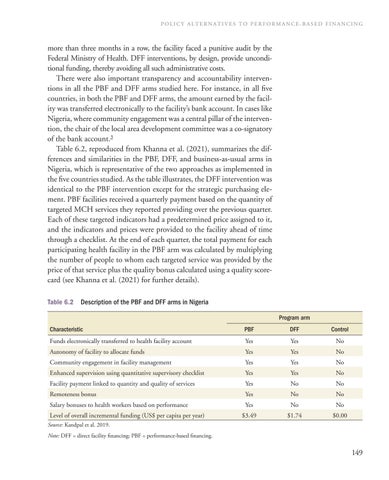POLICY ALTERNATIVES TO PERFORMANCE-BASED FINANCING
more than three months in a row, the facility faced a punitive audit by the Federal Ministry of Health. DFF interventions, by design, provide unconditional funding, thereby avoiding all such administrative costs. There were also important transparency and accountability interventions in all the PBF and DFF arms studied here. For instance, in all five countries, in both the PBF and DFF arms, the amount earned by the facility was transferred electronically to the facility’s bank account. In cases like Nigeria, where community engagement was a central pillar of the intervention, the chair of the local area development committee was a co-signatory of the bank account.3 Table 6.2, reproduced from Khanna et al. (2021), summarizes the differences and similarities in the PBF, DFF, and business-as-usual arms in Nigeria, which is representative of the two approaches as implemented in the five countries studied. As the table illustrates, the DFF intervention was identical to the PBF intervention except for the strategic purchasing element. PBF facilities received a quarterly payment based on the quantity of targeted MCH services they reported providing over the previous quarter. Each of these targeted indicators had a predetermined price assigned to it, and the indicators and prices were provided to the facility ahead of time through a checklist. At the end of each quarter, the total payment for each participating health facility in the PBF arm was calculated by multiplying the number of people to whom each targeted service was provided by the price of that service plus the quality bonus calculated using a quality scorecard (see Khanna et al. (2021) for further details). Table 6.2
Description of the PBF and DFF arms in Nigeria Program arm
Characteristic
PBF
DFF
Control
Funds electronically transferred to health facility account
Yes
Yes
No
Autonomy of facility to allocate funds
Yes
Yes
No
Community engagement in facility management
Yes
Yes
No
Enhanced supervision using quantitative supervisory checklist
Yes
Yes
No
Facility payment linked to quantity and quality of services
Yes
No
No
Remoteness bonus
Yes
No
No
Salary bonuses to health workers based on performance Level of overall incremental funding (US$ per capita per year)
Yes
No
No
$3.49
$1.74
$0.00
Source: Kandpal et al. 2019. Note: DFF = direct facility financing; PBF = performance-based financing.
149

